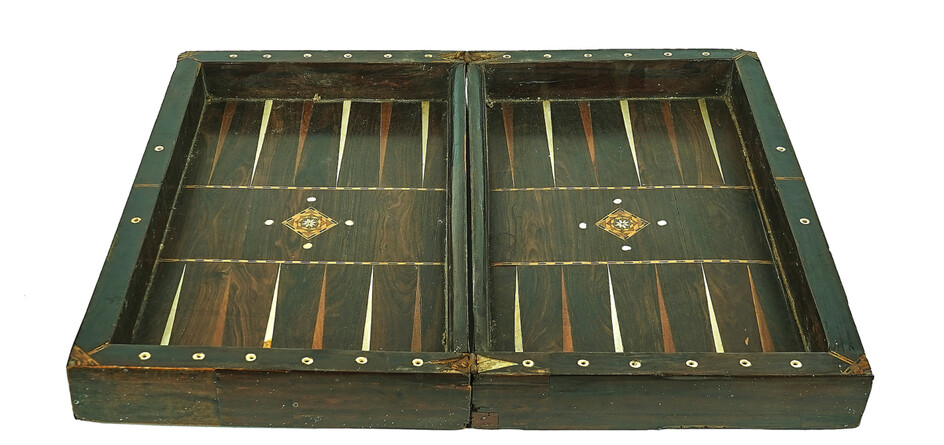A CONTINENTAL ROSEWOOD, FRUITWOOD AND IVORY INLAID FOLDING GAMES BOARD
Late 18th / Early 19th Century
The exterior inlaid with chessboard squares, the interior for backgammon with central inlaid micro-mosaic panels and corners, 63cm x 53cm open; 31.5cm x 53cm closed
The geometric decorative inlay to this board has its precedent in earlier, elaborate gaming boards originating from the Islamic period of the Moors ruling the Iberian Peninsular. Numerous recorded boards from the 14th Century onwards combine a use of materials and geometric motifs, inherited from the Umayyads and used throughout Spain and North Africa. The technique survived the Reconquista and was an influential decorative element in Renaissance furniture of Spain and Italy. For an example of a gaming board of a similar style, circa 1500, made in Italy see Hollander 2005, p.89, no.58.
Condition report:
Numerous losses, shrinkage cracks and related chips. Loss significantly along the hinged side, corners and front edges.
Some old patch repairs in areas.
The lozenge shaped patches lacking three with one remaining, possibly bone.
Some old worm evident to the carcass timber.
Some warping in areas.
Marks, some fading and general wear commensurate with use and age.
View it on
Sale price
Estimate
Reserve
Time, Location
Auction House
Late 18th / Early 19th Century
The exterior inlaid with chessboard squares, the interior for backgammon with central inlaid micro-mosaic panels and corners, 63cm x 53cm open; 31.5cm x 53cm closed
The geometric decorative inlay to this board has its precedent in earlier, elaborate gaming boards originating from the Islamic period of the Moors ruling the Iberian Peninsular. Numerous recorded boards from the 14th Century onwards combine a use of materials and geometric motifs, inherited from the Umayyads and used throughout Spain and North Africa. The technique survived the Reconquista and was an influential decorative element in Renaissance furniture of Spain and Italy. For an example of a gaming board of a similar style, circa 1500, made in Italy see Hollander 2005, p.89, no.58.
Condition report:
Numerous losses, shrinkage cracks and related chips. Loss significantly along the hinged side, corners and front edges.
Some old patch repairs in areas.
The lozenge shaped patches lacking three with one remaining, possibly bone.
Some old worm evident to the carcass timber.
Some warping in areas.
Marks, some fading and general wear commensurate with use and age.



